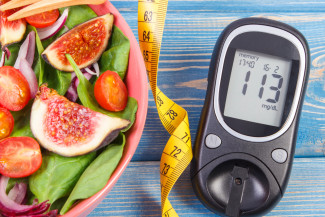
Johns Hopkins UniversityEst. 1876
America’s First Research University
Now Browsing:
Living with Diabetes during the COVID-19 Pandemic


By Michael W. Quartuccio, MD
Over 10% of the United States population has diabetes[1]. Long-term consequences of poorly managed diabetes include visual impairment, kidney failure, amputations, and a higher risk of heart disease or stroke. However, in the short term, poorly managed diabetes may impact the body’s response to a viral illness. Though the mechanism is not completely understood, high blood glucose levels (hyperglycemia) may result in a dysfunctional immune response to infection. This can lead to a more serious illness with infections than in those without diabetes. Using the example of the H1N1 influenza pandemic of 2009-10, studies showed that those with diabetes were 3 times more likely to be hospitalized and 4 times more likely to be admitted to an intensive care unit than those without diabetes[2]. This increased risk is especially important to consider during the COVID-19 pandemic.
Risk of/Severity of COVID-19 infection
Early data from China suggest that those with diabetes are likely not at higher risk of contracting COVID-19, but are at a higher risk of worse outcomes[3], including developing severe pneumonia[4]. This can result in a higher risk of admission to hospitals and the requirement for intensive care, potentially including intubation. Especially in those with type 1 diabetes, the risk of diabetic ketoacidosis (DKA) appears increased with infections. DKA is a life-threatening complication of diabetes involving very high glucoses and acid accumulation in the blood, which potentially results in coma or death. Overall, the risk of death from COVID-19 appears increased by up to 3 fold in those with diabetes[5].
Lowering your risk
Naturally, those with diabetes should follow the basic safety measures recommended by the Centers for Disease Control and Prevention (CDC): [6]stay home except for essential activities, wash your hands often, avoid touching your face, and consider wearing cloth masks in public. Try to minimize trips to the grocery store, but when you do go, plan for a supply of simple carbohydrates in case of hypoglycemia. These include juice, hard candy, or glucose tablets (available at most pharmacies).
Optimal glucose levels can help lower the risk. Take all diabetes medications as directed. Use your home blood glucose monitors according to directions from your diabetes provider. Write down the glucose values and the time of day checked. Try keeping a chart with this information. This can make it easier to relay abnormal values to your provider. To reduce trips to the pharmacy, ask for 3 month supplies of medications and consider home delivery of medications, which is covered by many insurance plans. Do not forget test strips, lancets, alcohol pads, syringes, and pen needles. Supplies of ketone test strips and glucagon might be appropriate, if recommended by your diabetes provider. Follow up regularly with your provider. Many offices now offer telephone or video visits. Alert your provider to abnormally high or low blood glucose values in between visits. High glucoses can increase the risk of worse outcomes, but could also be an early indicator of infection itself.
Do not forget that lifestyle makes a big impact on glucose levels. Maintain a healthy diet, focusing on a stable amount of carbohydrates eaten each day. Take advantage of the time at home to experiment with new, diabetes-friendly recipes. You can ask for ideas from your diabetes educator or search online. Exercising is important, whether that be using home exercise equipment, an exercise video (many online options exists), or walking outside (if social distancing guidelines can be adhered to). A goal should be 30 minutes of moderate intensity exercise (exerting yourself enough that you can talk, but not sing) 5 days per week. It is also important to stay hydrated and get plenty of rest.

For those who must work, persons with diabetes are covered by the Americans with Disabilities Act.[7] This law aims to protect those with disabilities, such as diabetes. It requires employers to offer “reasonable accommodations” to employees, in order to safely perform their jobs. This can include allowing those with diabetes to work from home, if possible. For essential employees who must go to work, “reasonable accommodations” can include allowing for appropriate social distancing, wearing a mask and/or gloves, and providing on-site parking options so employees can avoid public transit, if appropriate. If changes are not possible, job reassignment or leave might be considered. Additionally, the Families First Coronavirus Response Act (FFCRA) was passed by Congress in March and is designed to allow for paid leave for employees with coronavirus-related obstacles. These include employees who themselves are under quarantine because of COVID-19 exposure, who care for a family member who must quarantine, or who care for children whose school or daycare was shut down because of COVID-19.[8] Be sure to talk to your employer’s human resources department to learn more about your rights on the job.
Managing urgent situations
Now more than ever, emergency departments are for true emergencies only. Mild hypoglycemia, where someone feels sweaty or shaky but is able to safely eat, can typically be managed at home by eating fifteen grams of quick-acting carbohydrate and checking blood glucose fifteen minutes later. Of course, you should examine what caused the hypoglycemic event in the first place and reach out to your provider if they occur often. Severe hypoglycemia, resulting in the inability to wake the person or the inability for them to eat safely, is a medical emergency. Similarly, persistently elevated glucoses with vomiting, abdominal pain, or confusion are also an emergency. In these cases, you should always call 911. Do not dismiss new symptoms. When in doubt, call your diabetes provider to get advice. Catching problems early can prevent more serious illness.
Getting through this together
The COVID-19 pandemic has dramatically altered the way we live and interact. More than ever, it is important to support one another. Call and check in on family and friends with diabetes or other chronic health conditions. Keep regular contact with your diabetes provider, potentially using telemedicine. Just because we must distance, does not mean we should disconnect.
Michael W. Quartuccio, MD, is an adjunct assistant professor of medicine at the Johns Hopkins University School of Medicine and a clinical endocrinologist in the Rochester Regional Health System. He is coauthor of Diabetes Head to Toe: Everything You Need to Know about Diagnosis, Treatment, and Living with Diabetes, published by Johns Hopkins University Press.
[1] https://www.cdc.gov/diabetes/data/statistics/statistics-report.html
[2] Diabetes Care. 2010 Jul; 33(7): 1491–1493.
[3] J Endocrinol Invest. 2020 Mar 28. doi: 10.1007/s40618-020-01236-2.
[4] Diabetes Metab Res Rev. 2020 Mar 31:e3319
[5] JAMA. 2020 Feb 24. doi: 10.1001/jama.2020.2648.
[7] https://www.diabetes.org/coronavirus-covid-19/rights-for-workers-with-diabetes-during-coronavirus-pandemic
[8] https://www.dol.gov/agencies/whd/pandemic/ffcra-employee-paid-leave
Login to View & Leave Comments
Login to View & Leave Comments


